12 Most Popular Blue Cheeses in the World
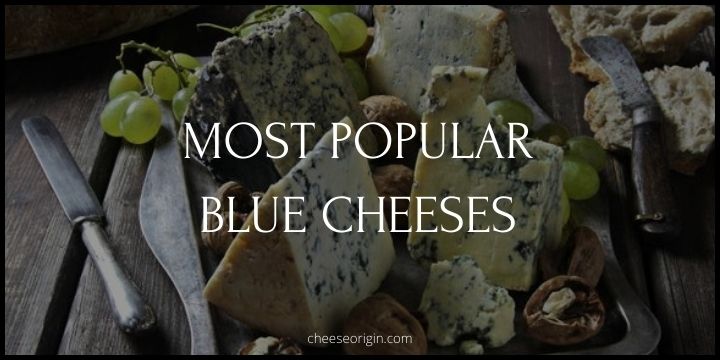
Welcome to the world of blue cheese, a universe teeming with bold flavors, striking textures, and rich histories. Each blue cheese variety tells a unique story – from the caves where they are aged to the milk that gives them life. In this guide, we’ll embark on a global journey exploring the 12 most popular blue cheeses.
From the piquant bite of Roquefort in France to the creamy richness of Gorgonzola in Italy; from the robust Valdeón in Spain to the tangy Maytag Blue in America; from the balanced Cashel Blue in Ireland to the other exceptional varieties scattered across the globe.
Prepare your palate for an adventure as we delve into the complex profiles of these culinary gems, their origins, and their perfect pairings.
Top 12 Best Blue Cheeses
| Cheese | Short Description | Tasting Profile | Origin |
|---|---|---|---|
| Gorgonzola | An Italian blue cheese made from unskimmed cow’s milk. | Creamy, buttery, with a bit of a bite from the blue veins. | Italy |
| Roquefort | A sheep milk blue cheese from Southern France. | Tangy, sharp, and salty with a creamy texture. | France |
| Stilton | Known as the King of Cheeses in England, it is made from pasteurized cow’s milk. | Rich and mellow, slightly sweet with a sharp finish. | England |
| Danish Blue / Danablu | A semi-soft blue-veined cheese made from cow’s milk. | Mild, slightly sharp and salty flavor with a creamy texture. | Denmark |
| Bleu d’Auvergne | A French blue cheese made from cow’s milk. | Spicy, with a hint of wildflowers and a creamy, crumbly texture. | France |
| Fourme d’Ambert | One of France’s oldest cheeses, made from raw cow’s milk. | Mild, fruity, and slightly woody. | France |
| Cambozola | A combination of French soft-ripened triple cream cheese and Italian Gorgonzola. | Mild and creamy with a slight tang from the blue veins. | Germany |
| Cabrales | A natural blue cheese made in the artisan tradition by rural dairy farmers in Spain. | Strong, spicy, slightly acidic, and very complex. | Spain |
| Saint Agur | A blue cheese made from pasteurized cow’s milk in Auvergne. | Creamy, smooth, with a balance of blue mold and salt flavors. | France |
| Valdeón Cheese | A Spanish blue cheese wrapped in sycamore maple or chestnut leaves. | Intense, slightly spicy, with a hint of sweetness. | Spain |
| Maytag Blue | An American blue cheese produced by the Maytag Dairy Farms. | Bold, tangy, and piquant with a crumbly texture. | USA |
| Cashel Blue | Ireland’s first blue cheese, made from cow’s milk. | Mild, creamy, with a hint of nutty flavors. | Ireland |
1. Gorgonzola
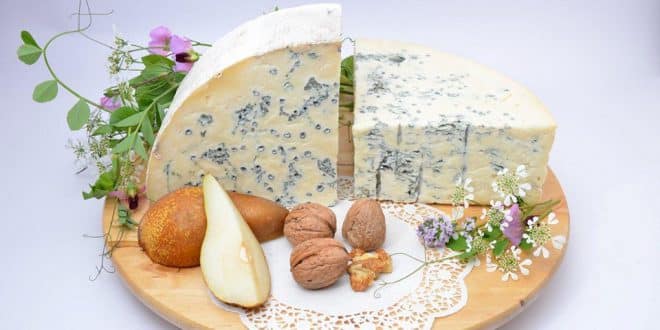
- Country of Origin: Italy
- Milk Type: Cow’s milk
- Taste: Creamy and salty with a bit of a bite
- Aroma: Mild and sweet
- Texture: Creamy
- Food pairing: Pears, figs, honey, walnuts
- Wine Pairing: Moscato d’Asti, Sauternes
- Read in-depth guide
Gorgonzola, a native of Italy, is one of the world’s oldest blue-veined cheeses. Its origins date back to the early centuries when it was produced in the town of Gorgonzola, lending it its name. Crafted from cow’s milk, this cheese is known for its creamy and salty flavor with a slight bite that delights the palate. It carries an aroma that is mild and sweet, perfectly contrasting its rich taste. Its creamy texture makes it a versatile ingredient in various culinary creations. Gorgonzola pairs wonderfully with fruits like pears and figs, and it’s a delight when drizzled with honey or paired with walnuts. When it comes to wine, you can’t go wrong with a Moscato d’Asti or Sauternes, making Gorgonzola a star of any cheese platter.
2. Roquefort
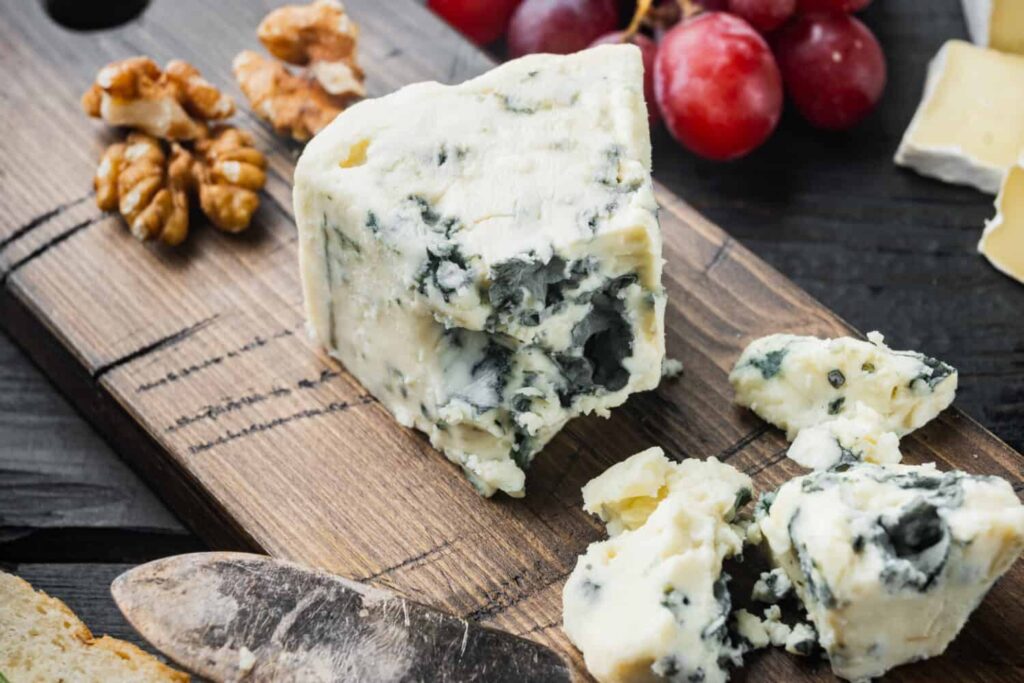
- Country of Origin: France
- Milk Type: Sheep’s milk
- Taste: Tangy, sharp, and salty
- Aroma: Strong and tangy
- Texture: Crumbly and slightly moist
- Food pairing: Figs, walnuts, honey
- Wine Pairing: Sauternes, Riesling
- Read in-depth guide
Roquefort, a cherished gem from the South of France, is revered as the “King of Cheeses”. This blue cheese boasts a rich history and is made from the milk of Lacaune sheep that graze on the diverse flora of the surrounding plateaus. The unique, natural caves of Roquefort-sur-Soulzon provide the perfect maturing environment for this cheese, giving it an unparalleled character. Roquefort has a moist and crumbly texture, with distinctive veins of blue mold. It offers a complex symphony of flavors – tangy, sharp, and slightly sweet with a smoky undertone. Its robust aroma and intense flavor make it a perfect companion to fruits like figs and nuts like walnuts. Pair it with a glass of Sauternes or a robust red wine for an unforgettable culinary experience.
3. Stilton
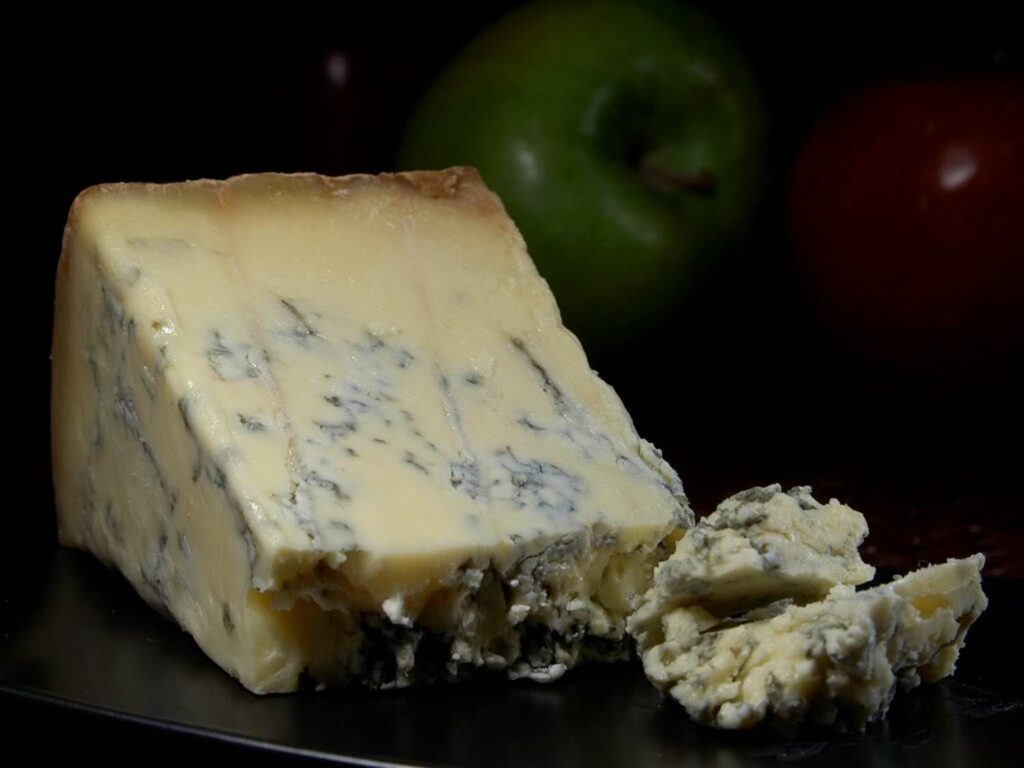
- Country of Origin: England
- Milk Type: Cow’s milk
- Taste: Rich and mellow, slightly sweet with a sharp finish
- Aroma: Fresh and clean
- Texture: Crumbly yet creamy
- Food pairing: Pears, apples, biscuits
- Wine Pairing: Port wine, Madeira
- Read in-depth guide
Stilton, often referred to as the “King of English Cheeses”, is a quintessential British blue cheese. Originating from the rural county of Leicestershire, Stilton is made from pasteurized cow’s milk and stands out with its distinctive cylindrical shape and crumbly yet creamy texture. It has an ivory-colored body marbled with striking blue veins that deliver a robust and complex flavor. The taste of Stilton is a harmonious blend of rich, mellow, and slightly tangy notes with an underlying sweetness. It boasts a strong and fruity aroma that becomes more pronounced as the cheese matures. Stilton pairs excellently with pears and apples, and it’s a dream when crumbled over salads or melted into soups. Complement it with a glass of Port or a full-bodied red wine to truly savor this classic blue cheese.
4. Danish Blue / Danablu
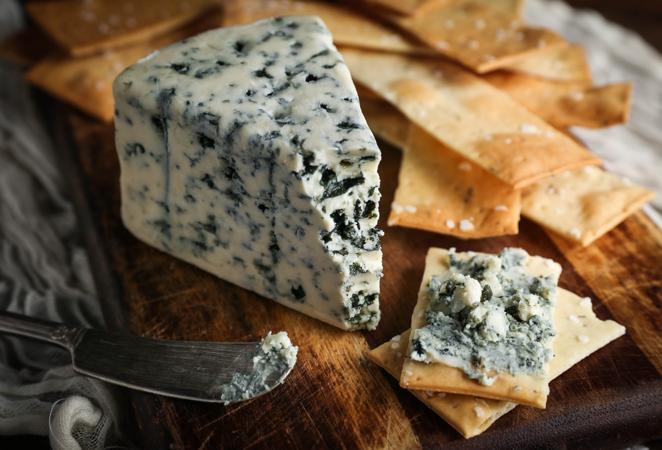
- Country of Origin: Denmark
- Milk Type: Cow’s milk
- Taste: Mild, slightly sharp and salty
- Aroma: Mild and creamy
- Texture: Semi-soft
- Food pairing: Salads, crackers, fruit
- Wine Pairing: Cabernet Sauvignon, Zinfandel
- Read in-depth guide
Danish Blue, also known as Danablu, is a standout in the world of blue cheeses. This cheese hails from Denmark and is made from the milk of Danish cows, resulting in a creamy and rich texture. It’s characterized by its semi-soft nature with a pale ivory color that’s beautifully contrasted by the network of pronounced blue veins running throughout. Danish Blue delivers a balanced flavor profile, offering a mild yet sharp taste with a hint of sweetness and a salty finish. Its aroma is invitingly pungent, adding to its overall allure. Whether it’s crumbled over a salad, melted into a sauce, or paired with fresh fruit and honey, Danish Blue shines brightly. For an elevated experience, enjoy it with a glass of Cabernet Sauvignon or a sweet dessert wine.
5. Bleu d’Auvergne
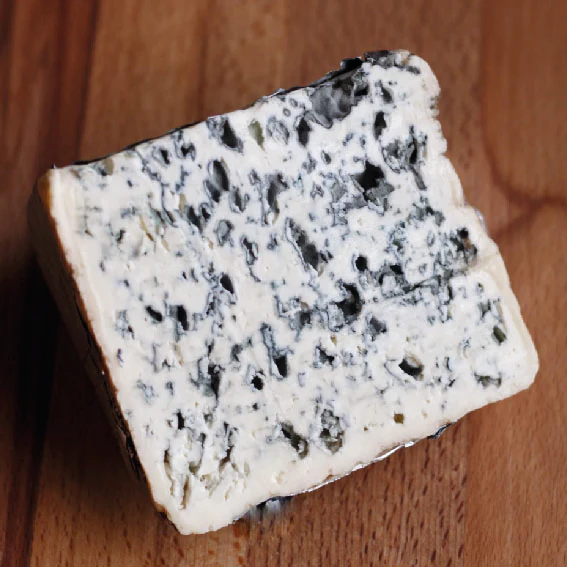
- Country of Origin: France
- Milk Type: Cow’s milk
- Taste: Spicy, with a hint of wildflowers
- Aroma: Grassy and floral
- Texture: Creamy and crumbly
- Food pairing: Grilled steaks, salads
- Wine Pairing: Sweet white wines, light red wines
- Read in-depth guide
Bleu d’Auvergne is a testament to the rich cheese-making tradition of France. Originating from the volcanic region of Auvergne, this blue cheese is made from cow’s milk and carries an Appellation d’Origine Contrôlée (AOC) status. Bleu d’Auvergne has a soft and creamy texture with a characteristic bluish-grey mold that gives it its distinctive look and taste. Its flavor is a remarkable blend of sweet, spicy, and salty notes, all underpinned by a hint of earthiness. The aroma is robust, reflecting its strong and complex flavor profile. Whether it’s spread on a piece of crusty bread, crumbled atop a salad, or paired with fruits and nuts, Bleu d’Auvergne never fails to impress. Pair it with a full-bodied red wine or a sweet white wine to enhance its delectable taste.
6. Fourme d’Ambert

- Country of Origin: France
- Milk Type: Cow’s milk
- Taste: Mild, fruity, and slightly woody
- Aroma: Mild and earthy
- Texture: Creamy and firm
- Food pairing: Pears, apples, crusty bread
- Wine Pairing: Sweet white wines, light red wines
- Read in-depth guide
Fourme d’Ambert, a jewel in the crown of French cheesemaking, hails from the mountainous Auvergne region. This blue cheese is one of France’s oldest, dating back to Roman times, and carries an Appellation d’Origine Contrôlée (AOC) status. Made from cow’s milk, Fourme d’Ambert boasts a unique cylindrical shape and a striking blue-grey mold that makes it stand out on any cheese board. Its creamy and firm texture is complemented by a remarkably balanced flavor, offering mild, mushroomy notes with a subtle hint of sweetness. The aroma of Fourme d’Ambert is earthy yet not overpowering, adding to its overall charm. This cheese is a versatile culinary companion – excellent when melted into pasta dishes, crumbled into salads, or simply enjoyed with a slice of pear and a drizzle of honey. Pair it with a full-bodied, fruity red wine to truly appreciate its exquisite taste.
7. Cambozola

- Country of Origin: Germany
- Milk Type: Cow’s milk
- Taste: Mild and creamy with a hint of mushroom
- Aroma: Earthy
- Texture: Creamy and smooth
- Food pairing: Grapes, almonds, baguette
- Wine Pairing: Chardonnay, Riesling
- Read in-depth guide
Cambozola is a delightful cheese that masterfully blends the richness of French soft-ripened triple cream cheese with the piquant flavors of Italian Gorgonzola. This German blue cheese presents a luxurious, creamy texture, speckled with delicate blue veins that offer a mild, yet nuanced flavor. Cambozola stands out with its bloomy white rind, reminiscent of Camembert, and its interior delivers a harmonious balance of sweet, earthy, and tangy notes. The aroma of this cheese is subtly inviting, adding to its overall appeal. Whether it’s spread on warm, crusty bread, drizzled with honey, paired with fresh fruits, or melted into gourmet dishes, Cambozola offers a versatile and indulgent experience. For a perfect pairing, enjoy it with a glass of Riesling or a robust red wine.
8. Cabrales

- Country of Origin: Spain
- Milk Type: Cow’s, goat’s and sheep’s milk
- Taste: Strong, spicy, slightly acidic
- Aroma: Intense and pungent
- Texture: Firm and crumbly
- Food pairing: Grilled meats, salads
- Wine Pairing: Sherry, full-bodied red wines
- Read in-depth guide
Hailing from the green pastures of northern Spain, Cabrales is a blue cheese that showcases the rich dairy heritage of the region. Traditionally made from raw cow’s milk or a blend of cow, sheep, and goat’s milk, Cabrales is recognized for its strong, intense flavor and pungent aroma. This unique cheese is aged in natural limestone caves, where it develops a robust character and a striking network of blue-green veins running through its semi-hard texture. The flavor of Cabrales is complex – sharp and tangy, yet with an underlying sweetness that balances its intensity. Its bold taste makes it perfect for savoring on its own, crumbled over salads, or melted into hearty dishes. Pair Cabrales with a full-bodied Spanish red wine or a crisp cider to fully appreciate its exceptional taste.
9. Saint Agur
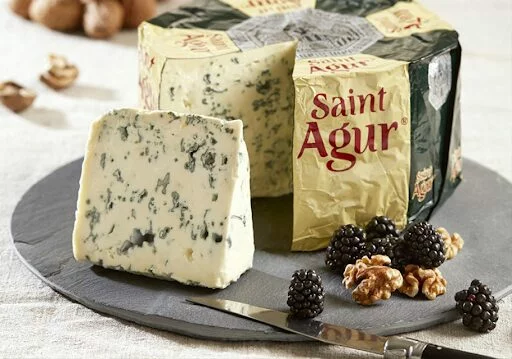
- Country of Origin: France
- Milk Type: Cow’s milk
- Taste: Creamy, salty, tangy
- Aroma: Mild
- Texture: Creamy and buttery
- Food pairing: Fruits, crackers
- Wine Pairing: Sweet white wines, light red wines
- Read in-depth guide
Saint Agur is a blue cheese that hails from the mountainous Auvergne region of France. Made from pasteurized cow’s milk, this double-cream cheese offers an indulgent, creamy texture that is punctuated by intense blue veins. Its distinctive octagonal shape sets it apart, making it a standout addition to any cheese platter. Saint Agur delivers a unique flavor profile – it’s robust and sharp, yet underpinned by a buttery richness and slight tang that lingers on the palate. The aroma is invitingly pungent, adding depth to its overall character. Whether it’s spread on fresh baguette, crumbled into salads, or melted into pasta dishes, Saint Agur presents a versatile and sumptuous cheese experience. Pair it with a sweet dessert wine or a crisp apple cider for a delightful gastronomic treat.
10. Valdeón

- Country of Origin: Spain
- Milk Type: Goat’s and cow’s milk
- Taste: Sharp, intense, slightly sweet
- Aroma: Strong
- Texture: Creamy
- Food pairing: Honey, fig jam
- Wine Pairing: Full-bodied red wines, dessert wines
- Read in-depth guide
Valdeón is a robust Spanish blue cheese that originates from the high Picos de Europa mountains. Made from a blend of cow’s and goat’s milk, it’s wrapped in sycamore maple or chestnut leaves, giving it an unmistakable rustic appeal. Valdeón presents a semi-soft texture, speckled with assertive blue-green veins that hint at its bold, complex flavor. It’s less piquant than its cousin Cabrales but still packs a punch with its rich, spicy, and slightly salty taste. The cheese’s aroma is earthy and intense, reflecting its cave-aged maturation process. Valdeón is versatile – it can be savored on its own, crumbled over salads, or used to add depth to sauces and pasta dishes. To fully appreciate its character, pair it with a full-bodied red wine or sweet dessert wine.
11. Maytag Blue

- Country of Origin: United States
- Milk Type: Cow’s milk
- Taste: Tangy, peppery, slightly pungent
- Aroma: Mildly pungent
- Texture: Crumbly and dense
- Food pairing: Pears, walnuts, honey
- Wine Pairing: Cabernet Sauvignon, Zinfandel
- Read in-depth guide
Maytag Blue is a high-quality American blue cheese, originating from the rolling hills of Newton, Iowa. A product of the Maytag Dairy Farms, this cheese is made from the milk of prize-winning Holstein cattle, and its creation process is closely overseen from start to finish. Maytag Blue has a semi-soft texture, with distinctive blue veins that contribute to its sharp and tangy flavor. It has a crumbly yet creamy consistency that melts in the mouth, releasing a slightly spicy note that sets it apart from other blue cheeses. Its aroma is rich and pungent, echoing its strong flavor profile. Maytag Blue is versatile – it shines when crumbled over salads, melted on burgers, or enjoyed with a slice of pear. Its bold flavor pairs well with a robust red wine or a sweet port.
12. Cashel Blue
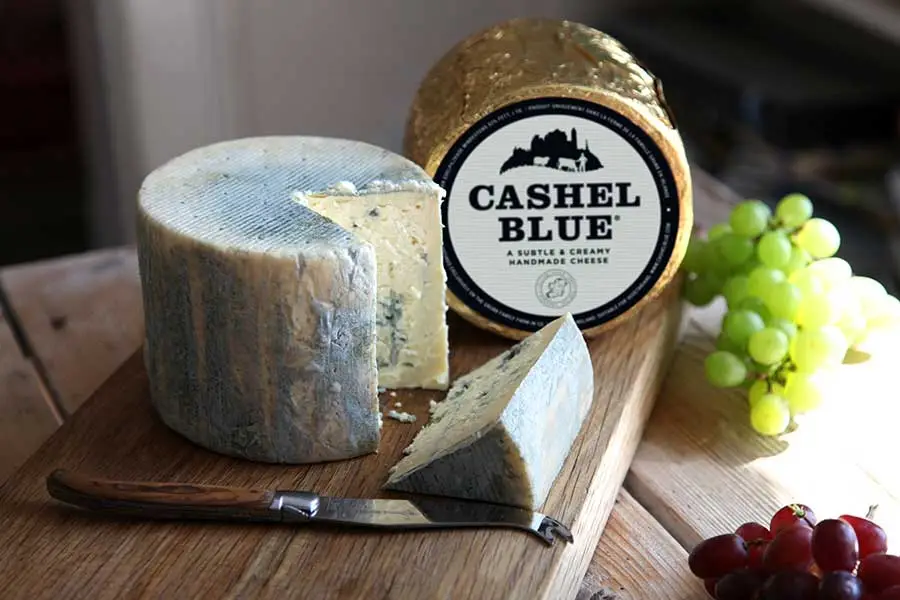
- Country of Origin: Ireland
- Milk Type: Cow’s milk
- Taste: Mild, sweet, slightly nutty
- Aroma: Milky, slightly sweet
- Texture: Semi-soft, creamy
- Food pairing: Apples, pears, crusty bread
- Wine Pairing: Port wine, full-bodied red wines
- Read in-depth guide
Cashel Blue is a distinctive Irish cheese that hails from the lush pastures of County Tipperary. Named after the historic Rock of Cashel, this farmhouse blue cheese is made from the milk of Holstein-Friesian cows. Cashel Blue has a unique semi-soft texture, with delicate blue veining throughout its buttery, ivory-colored paste. Its flavor is well-balanced – a harmonious blend of creamy, nutty, and tangy notes with a gentle hint of pepper. The aroma is mild and inviting, making it a perfect introduction for those new to blue cheese. Cashel Blue is highly versatile, gracing anything from cheese boards to salads, and it melts beautifully into pasta dishes. Paired with a fruity red wine or a crisp apple cider, it offers an authentically Irish cheese experience.
Also read: The Art of Blue Vein Cheese: A Journey Through Flavor and Texture
Final Thoughts
As we wrap up our global tour of the 12 most popular blue cheeses, it’s evident that each one is a testament to the artistry and tradition of cheese making. From the creamy to the crumbly, the mild to the piquant, these blue cheeses showcase a remarkable range of textures and flavors.
They are not just food items, but narrators of rich cultural stories and ambassadors of their regions. Whether enjoyed on a cheese board, melted into a dish, or paired with wine, they bring a unique culinary delight to our tables.
Although we’ve explored the crevices of these twelve, remember that the world of blue cheese is vast and varied, and there’s always another variety waiting to be discovered. So keep exploring, keep tasting, and most importantly, keep enjoying the blue!
Also read:
- What is Queso de Murcia? The Wine-Soaked Delight
- 5 Most Popular Cheeses Originated in Argentina
- What is Reggianito? Argentina’s Little Parmesan & Its Bold Flavor
- What is Cornish Blue? Unraveling the UK’s Young Blue Cheese
- What is Beemster Classic? A Timeless Cheese from Holland
- What is Coolea Cheese? Cork’s Sweet and Nutty Delight
- What is Reggianito? Argentina’s Little Parmesan & Its Bold Flavor





